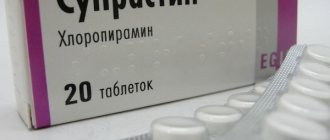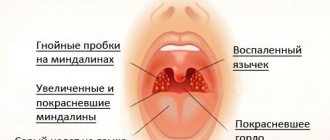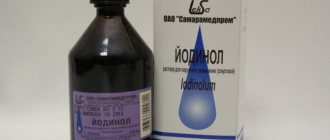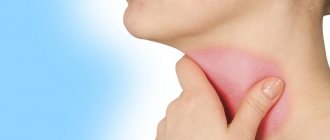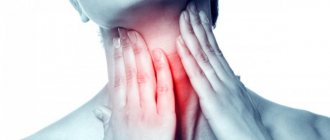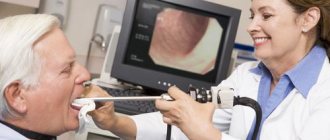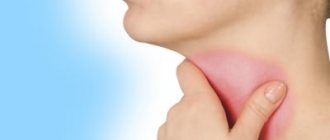The throat is particularly sensitive, and even the slightest injury causes discomfort and pain. With a serious burn to the throat, not only the surface of the mucous membranes can be damaged, but also tissues and organs that lie deeper. Children and careless or very quick people are especially at risk for this type of burn. To avoid injuries of this kind, you should follow simple safety rules, be careful and avoid haste in everyday activities. For example, you can easily get, although not significant, but still an unpleasant throat injury in the morning, rushing to work in a hurry to take a large sip of tea that has not cooled down to a safe temperature. The food gets burned precisely because of the rush. Chemicals and their vapors can also cause this disease. Such dangerous things should be stored out of the reach of children, in securely closed containers that should be signed. It is better to treat minor burns of the throat mucosa under the supervision of a physician. It would be a good idea to know what to do if you have a throat burn.
Distinctive characteristics
The throat is most vulnerable to various types of injuries, including burns, since its delicate tissue structure is highly sensitive and can be easily damaged.
A burn in the throat is different in that it is internal and affects the larynx, palate and esophagus. The extent of damage depends on the severity of the injury. The burned area cannot be covered with a bandage, and the injured areas are difficult to reach for treatment. With this type of damage, the swallowing reflex may disappear for a long time, which will make it impossible to eat food naturally.
With such damage, the following are felt: Acute pain, increased salivation, increased body temperature, the affected area of the throat burns, the person may feel sick, dry cough, hoarseness, swelling of the affected area, swollen lymph nodes, lack of oxygen.
In very dangerous stages, bleeding wounds, blisters appear, the upper layers of tissue are severely damaged, painful shock and respiratory collapse may occur.
Burn severity
When burned with boiling water, the oral cavity and palate, as well as the larynx, esophagus and trachea are injured. A chemical burn is more dangerous to human health and life. It can be identified by the smell of the mouth and vomit. Moreover, it affects not only the mucous membrane, but also muscle tissue.
There are 3 degrees of severity of thermal and chemical burns:
- Injury to the surface layer, accompanied by the appearance of swelling and slight redness of the throat mucosa. A person may experience pain and a burning sensation in the throat, but his health does not deteriorate much.
- More severe tissue damage, which is accompanied by the appearance of blisters and gray films. The throat becomes red and swollen. After 2 weeks, the plaque will begin to separate. Scars will appear in place of the blisters. The victim's illness will last for about half a month, and the body temperature can rise to 38ºC.
- Death of burned tissues with severe intoxication of the body. Its symptoms are the appearance of dense crusts and scabs. After 2 weeks, ulcers appear in their place. When they heal, they leave scars that interfere with the normal functioning of the pharynx, larynx and esophagus.
In case of a 2nd or 3rd degree burn, the patient is urgently hospitalized, and further treatment is carried out in the hospital. You cannot delay hospitalization, otherwise the person may die from poisoning or suffocation. A patient with a 1st degree burn can be treated at home, but under medical supervision. As a rule, light burns do not leave a trace.
Treatment of burns is a long process, which, in addition to therapy, involves following a certain diet and limiting conversations.
The patient should not eat spicy or sour foods. Food should not be hot and mashed so as not to injure a sore throat. The diet is supplemented with chicken egg whites and oils.
Depending on the severity of the burn, therapy may include:
- broad-spectrum antibiotics;
- administration of glucose, hemodez, rheopolyglucin;
- sedatives;
- injecting oily substances into the throat.
Causes
Thermal burn affects the throat when ingesting hot food or drink, and chemical burn when the throat is exposed to medications, alcohol, acids or chemicals.
The main causes of this type of damage are negligence and carelessness when interacting with hot liquids, food, as well as chemicals, alcohol-containing liquids and medications of a certain group.
Alcohol and alcohol . The risk group primarily includes socially vulnerable citizens suffering from addiction, who consume alcohol-containing liquids and low-quality alcoholic beverages for other purposes.
Damage from alcohol-containing liquids occurs if the alcohol concentration in them is more than 70 percent. This is the easiest type of lesion, since a membrane forms on the mucous membrane that does not allow alcohol to penetrate deep into the surface layer of the epithelium. If alcohol penetrates into the esophagus, a white coating of dead tissue cells appears on its internal surfaces.
The injury is accompanied by the following manifestations: pain in the chest and cervical region, weakness appears in the stomach, and the sensitivity of taste buds is dulled.
Hospitalization, if the esophagus is not damaged, is not required and after some time the tissue cells will recover on their own.
Hot food and liquid . Most often, the throat is burned by hot tea or food, as well as by inhalation of hot steam. Thermal burn of the throat occurs in most cases and does not pose a great danger if it does not penetrate into the deep layers of the mucous membrane. But it all depends on the temperature of the food, steam or drink ingested and on the time of action of the hot agent.
Children are most susceptible to these types of injuries. Therefore, to prevent a child from getting a burn on the palate from hot food, you should always check the temperature of the food served on the table.
There are three degrees of burn injury:
- First degree. Acute pain, the mucous membrane turns red.
- Second degree. The appearance of a gray-white plaque with liquid blisters.
- Third degree. Tissue death is observed.
The first and second degrees of severity are the most common and with proper treatment, regeneration of damaged areas occurs quickly. Grade 3 is very rare, it is the most difficult and can only be treated in a hospital.
Burn of the larynx with gastric juice . In diseases accompanied by the release of bile, you can get injury to the larynx caused by gastric juice.
Symptoms of damage: sharp pain, irritation of the mucous membrane, a feeling of chest compression, gag reflex, heartburn, increased formation of bile after eating heavy food.
Causes of burns and symptoms
You can burn your throat not only with hot food and tea. Another cause of such injuries is exposure to chemicals, for example, in industrial and chemical production, during suicide attempts, or through improper or careless use of chemicals in everyday life. As a result, the pharynx, outer part of the larynx, and esophagus can be seriously damaged. In the vast majority of cases, the prognosis for recovery depends on the speed at which the person receives help. And further treatment of a burn caused by boiling water and chemical burns will be different.
Chemical burns are caused by:
- caustic alkalis;
- concentrated acids;
- ammonia;
- poisonous vapor;
- iodine and Lugol.
A burn to the mucous membrane of the throat by toxic fumes can be caused by a fire, and iodine and Lugol cause injury to the throat if they are used incorrectly to treat sore throat and pharyngitis.
A person with a burn to the throat experiences pain when swallowing, a burning sensation in the throat and severe salivation. Nausea and vomiting may occur. In case of severe injuries, the body temperature rises, the lymph nodes swell, and shock may develop. A burn to the larynx leads to damage to the vocal cords, coughing and lack of air. The general well-being of a person who has burned his throat depends on the amount of the traumatic substance and the body’s reaction.
Chemical burn and its signs
Chemicals such as acids and alkalis, as well as their vapors, if they enter through the oral cavity or nasopharynx, cause this type of injury. You should also be very careful with medications, for example, iodine or Lugol, which can cause chemical damage.
Chemical injuries are more dangerous than thermal ones, since after ingestion they have a destructive effect on tissue cells for a long time. The general symptoms of the chemical type are basically the same as for thermal injury: acute pain, the mucous membrane becomes red, and a strong burning sensation is felt.
When lubricating the throat during inflammation of the tonsils, there is a chance of getting a throat burn with Lugol if it is highly concentrated.
During radiotherapy of the mucous membrane, if the dosage of the drugs is not observed, a burn from electrophoresis is possible. To prevent this from happening, you must know the list of contraindications for this procedure.
A burn of the larynx by gastric juice also refers to a chemical type of injury, but is classified as a separate type.
Symptoms and signs
The symptoms of a burn are generally similar regardless of the type, but there are some differences:
- Severe pain in the pharynx at rest;
- Excruciating, high-intensity pain when speaking or swallowing;
- Excessive salivation;
- Nausea and vomiting;
- Swelling of the affected tissues;
- Soreness and swelling of the lymph nodes;
- Temperature increase;
- The presence of a characteristic odor from the mouth due to a chemical burn;
- In case of a burn with iodine, the vomit may turn brown or bluish;
- In case of an alkaline burn, the vomit has an oily consistency and contains mucous particles;
- With degrees 2 and 3, the person’s condition as a whole suffers;
- Severe burns can cause suffocation and collapse.
If the burn penetrates the respiratory tract, then there may also be a cough, a feeling of lack of air, pain in the sternum, and a change in voice. If the esophagus is damaged, the pain becomes more severe when swallowing or vomiting.
Isolated burns are usually not dangerous, and the severity rarely exceeds 2nd degree. The most unpleasant symptom is severe pain, which goes away in about 1 week.
Symptoms and causes of laryngeal burn:
Further treatment
Treatment at home. Treatment of such ailments in a mild form can be carried out at home, since there is no threat to the life and health of the victim, and the treatment is not complicated.
1st and 2nd degree burn injuries to the throat are not very dangerous and can be easily treated at home. It can be treated both with the use of medications and by resorting to folk remedies. Typically, rosehip oil is used, and when gargling, soothing, healing herbs are used. But still, before treating a burn in the throat, it is strongly recommended to consult a doctor.
Means for treating a burn of the larynx with boiling water.
In this case, drugs of the following types are used: almagel, phosphalugel, de-nol, rennie, methyluracil, motilium, gaviscon, vitamins A and E, lanza and nolpaza.
All these drugs are available, but consultation with a doctor is necessary.
Hospital treatment. The most dangerous injuries of this type are classified as third degree and are treated only under the close supervision of doctors and only in a hospital.
Treatment of a chemical burn of the throat, which is quite complicated, is often a consequence of the patient’s failure to comply with basic rules and regulations and occurs due to negligence. When a chemical substance, which can have a different composition, enters the human body, it provokes the destruction of cells to a state of complete necrosis.
The reasons for the occurrence of such a dangerous injury can be different: work in hazardous enterprises and failure to comply with basic standards or self-medication, which involves lubricating the throat with any substances. Often, a burn for the second reason occurs in adults and children, and its cause is the use of Lugol's solution, iodine or brilliant green to lubricate the mucous membranes.
It is worth noting that interventions of this kind are possible only after consultation with a specialist. In some cases, in the presence of contraindications and in conditions of non-compliance with basic standards, such treatment will cause dangerous consequences.
Causes and stages of burns to the throat mucosa
The most common cause of oral burns is exposure to high temperatures. This occurs when eating hot food, drinks, or inhaling vapors. Thermal burn in most cases does not affect the deep layers of tissue, since the effect of high temperatures is short-lived. Most often, 1st and 2nd degree burns are diagnosed; 3rd degree burns are extremely rare.
With proper and timely treatment, the damaged areas of the throat are completely restored, the functionality of the pharynx, nasopharynx, larynx, and oral cavity is restored. Thermal destruction of the mucous membrane in most cases is diagnosed in children of preschool and primary school age.
Chemical burns of the throat are less common in toxicology, but pose a great danger to human health. When potent substances of organic and inorganic nature come into contact with the epithelium of the throat, large-scale tissue destruction occurs, which is often irreversible.
Chemical burns are characterized by 3rd and 4th degree damage. This is accompanied by the formation of necrotic areas, charring of tissues and their disintegration. This condition leads to high intoxication of the body, the addition of pathogenic bacterial flora, and the development of life-threatening complications - sepsis, endotoxic shock.
Irreversible destruction is due to the fact that when it comes into contact with the mucous membrane, the chemical substance acts on the tissue for a long time. The longer the contact of the poison with the tissues remains, the more severe the damage.
Substances that cause throat burns:
- high concentration acids and alkalis;
- alcohols;
- heavy metal salts;
- oil-containing products.
Burns caused by the ingestion of toxic substances occur in young children. This happens when parents neglect the rules for storing household chemicals. Chemical damage to the mucous membrane of the throat occurs in adults with unstable mental health and suicidal tendencies.
Causes
A chemical burn to the oral mucosa can occur to anyone who works in a chemical production facility and does not comply with the basic safety rules. It should be remembered that burns of the oral mucosa are often combined with characteristic lesions of the larynx, and in severe cases of the esophagus; a chemical burn of the tongue is often detected.
Important! Providing first aid to the victim is the key to successful subsequent therapy. Therefore, it is difficult to overestimate the value of such knowledge - every adult should have it. The instructions are quite simple, but following them in some situations can save the victim’s life and prevent dangerous complications.
The circumstances surrounding the injury may vary. They are often associated with the use of household chemicals at home. They can be used by adults through negligence, and by children out of ignorance.
Burns in the workplace can result from inhalation of various chemicals. Their particles can settle in the respiratory tract. Such complications are encountered by people who neglect safety rules and refuse to work while wearing a respirator.
Important! A chemical burn of the larynx and trachea according to ICD 10 has a code of T27. 4.
There are a sufficient number of chemicals that can cause burn injuries.
Their list includes:
- vinegar solution;
- ammonia solution;
- battery fluid;
- iodine solution;
- perhydrol;
- sodium hydroxide;
- detergents, various household chemicals.
It is worth remembering that alkaline damage to the mucous membranes of the oral cavity is the most dangerous. The substance causes wet necrosis and can interact with living tissue for an extended period of time. Treatment in this case is associated with special difficulties.
Various symptoms appear depending on the severity of the damage, which depends on several factors:
- duration of influence of the substance on the mucous membrane;
- type of chemical reagent;
- amount of reagent.
The list of symptoms characteristic of this condition can be presented as follows:
- pain in the throat;
- intense salivation;
- increase in the patient's body temperature;
- burning and swelling of the mucous membranes;
- feeling of lack of air;
- shortness of breath;
- nausea and vomiting.
Degree of damage
The degrees of damage to the larynx are discussed in the table:
| Degree of damage from chemical reagents | |
| 1st degree | By this definition I mean a superficial lesion. The area of the mucous membranes has a pale color. After injury, skin particles die off on the 3rd day. General intoxication of the body does not appear. |
| 2nd degree | This stage is characterized by symptoms of general intoxication. There are no large scars, but erosive foci are present. |
| 3rd degree | There are signs of general intoxication, body temperature rises significantly. Vomiting occurs and blood may be present in the masses. Ulcers form on the affected areas and are replaced by scar tissue. |
The prognosis for recovery from a 3rd degree burn is unfavorable. A lethal outcome is also possible with a 1-2 degree burn, provided that first-aid is not provided in a timely manner and the required therapy is not available. Only a doctor can accurately assess the patient’s condition and develop an action plan.
The video in this article will tell the reader why burns from acids and alkalis are dangerous.
Emergency measures for burns
The severity and outcome of the burn directly depends on how quickly qualified medical care was provided.
In case of a thermal burn, in order to cool the mucous membrane and reduce the pain symptom, the oral cavity and pharynx should be rinsed with cool water (12-18°C) for 15-20 minutes.
If the affected area is extensive, the pain is severe, swallowing is difficult and the voice is hoarse, you must call an ambulance or take the victim to the hospital yourself. While waiting for medical personnel, it is better to take the person out into the fresh air and prohibit him from talking.
In most cases, thermal burns to the throat can be treated at home. Signs of a patient's condition that should promptly consult a doctor:
- nausea and vomiting appeared;
- body temperature has increased and is not relieved by antipyretic drugs within 12 hours;
- a day after the incident, the pain did not decrease, but intensified;
- the oral mucosa turned redder after 24 hours than immediately after the burn, and the area of the wound surface increased;
- lack of sensitivity (numbness in the mouth and throat).
If a person has a chemical burn to the mucous membrane of the throat, then rinsing should be more intense and longer. To do this, use warm water or milk. In order to prevent burns of the esophagus and stomach, the victim is recommended to drink 1-2 glasses of warm milk after the mouth and throat have been thoroughly washed for 10-15 minutes.
In case of a burn caused by oil-containing products, it is strictly forbidden to rinse the mucous membrane with water. Rinse your mouth only with vegetable oil. You can also take it orally (2-3 tablespoons).
It is strictly forbidden to use any chemical substances to neutralize poisons. The 24 Hour Rule must be followed. This means that within 24 hours after toxic elements enter the body, you cannot use any antidotes or pharmacological drugs. They can enter into an unpredictable reaction and significantly worsen the victim’s condition.
First aid for a burn of the larynx:
- exclude conversations and any stress on the vocal cords;
- gargle with cool, clean water;
- immediate transportation of the victim to the hospital (with a second degree burn, severe swelling of the organ develops, which at any moment can immediately block the airways and lead to shock or respiratory arrest).
Urgent Care
A chemical burn of the larynx or oral cavity is quite dangerous and the patient’s prognosis for recovery largely depends on the correctness and timeliness of first-aid care. The method of therapeutic intervention is determined after interviewing eyewitnesses.
The factor of damage can be determined by examining the affected area:
- acid lesions – dry scab on the mucous membranes;
- alkaline lesion - the scab has a jelly-like, moist character, the mucous membranes are loose.
Important! First aid for acid and alkali burns is aimed at neutralizing the effect of a toxic substance that has entered the patient’s body.
For acid burns, it is recommended to take a soda solution, and for alkaline burns - acetic or citric acid. The patient should rinse the stomach and offer a glass of natural milk or a small piece of butter.
Treatment
Regardless of the nature of the injury received and the type of toxic substance, the patient is administered antibacterial and painkillers. Such remedies eliminate the resulting swelling and suppress disturbing symptoms.
After assessing the severity of the injuries, the approximate length of the patient's stay in the hospital is determined. The patient can continue treatment as an outpatient after the risk of dangerous complications has decreased.
During the recovery period, the victim must follow the following recommendations:
- eliminating stress on the vocal cords;
- adherence to a special diet that limits the consumption of solid foods;
- It is forbidden to eat salty, sour and spicy foods - they can irritate the throat and mouth;
- carrying out inhalations;
- rinsing the throat and mouth with antiseptic solutions.
Attention! Burns can be caused by chemical vapors, so patients working in hazardous enterprises must follow safety precautions and carefully monitor their own well-being.
Treatment of a burn to the throat mucosa at home
Only minor burns are treated on an outpatient basis (that is, at home). In addition to the use of medications, it is necessary to observe a protective regime.
In the first days after injury, you should strain the ligaments less.
Food should be gentle (no hot and spicy seasonings, sour foods excluded, mashed, pureed), it should not be hot. For drinks, it is recommended to drink water and weak and not hot tea.
If drug treatment at home within 2 days does not bring relief, then it is necessary to consult a doctor to decide whether hospitalization is necessary and change treatment tactics.
Use of drugs
Chemical and thermal burns of the throat can be treated at home using various groups of drugs:
- Antiseptics : Miramistin, Furacilin, Tantum Verde. These solutions are used to gargle and treat the mucous membrane. They destroy pathogenic flora;
- Painkillers (Analgin, Tempalgin, Baralgin) in the form of tablets and injection solutions. In the hospital, potent and narcotic drugs are used. This is necessary to eliminate pain;
- Antihistamines in the form of tablets and solutions for oral and parenteral administration (Suprastin, Loratadine, Diazolin). They are necessary to reduce swelling, itching and burning;
- Sedatives are prescribed to relieve stress and anxiety. Such drugs include tincture or tablets of valerian, motherwort, and so on;
- antibiotics are indicated in cases where there is a high risk of infection. Antibacterial drugs are prescribed only by the attending physician. Self-medication in this case is not acceptable.
Traditional methods
There are a large number of folk recipes that will help treat a burnt throat.
It should be remembered that you can turn to traditional medicine only for a burn of 1st degree of severity.
Folk remedies that will help in the treatment of chemical, thermal burns of the throat and burns after radiation therapy:
- For gargling, decoctions of herbs that have an anti-inflammatory effect are used. Such medicinal herbs are chamomile, yarrow and calendula. A decoction is prepared either from one plant or from a combination of herbs;
- If you burn (burn) your throat with hot food (food) or tea, the following dairy products will help: sour cream, milk, cream and butter. These foods should be kept cool. In this case, cooling and softening of the burn occurs;
- Treat the affected mucous membrane with sea buckthorn or olive oil;
- Rosehip decoction can be used for rinsing and ingestion. It has a general strengthening and anti-inflammatory effect.
Throat burn: what not to do
Unauthorized therapy often causes more dangerous consequences for the patient; the recovery period can be significantly extended. Failure to comply with basic therapeutic standards increases the risk of developing infectious complications.
Persons who have received this type of injury must comply with the following recommendations:
- It is prohibited to consume hot foods and drinks;
- Drinking alcohol is not recommended;
- it is important to control the volume of your voice, it is forbidden to strain your ligaments;
- the patient must give up nicotine addiction.
The listed recommendations are quite simple and they are general, but despite this it is impossible to dispute their effectiveness. The following tips can significantly speed up and facilitate the period of complete recovery.
Prevention
It is worth remembering that a chemical burn in the mouth often occurs precisely through the fault of the person himself and is the result of failure to follow safety precautions.
In order to prevent the manifestation of a dangerous situation, you need to pay attention to the rules of prevention and ensure your own safety as necessary:
- young children should not be left for long periods of time without adult supervision;
- it is prohibited to leave household chemicals and other caustic substances within sight or reach if there is a small child in the house;
- hazardous substances, including acids, should be stored out of the reach of children;
- people working in hazardous chemical production must strictly follow safety rules;
- Knowledge of first aid rules must be mandatory.
Complications
A chemical burn to the mouth and throat (pictured) can cause dangerous complications in the patient.
The list of the most dangerous consequences can be presented as follows:
- internal bleeding;
- perforation of the stomach or esophagus;
- general, increasing intoxication of the body;
- respiratory rate disturbances;
- respiratory arrest;
- shock;
- collapse;
- formation of scar changes on the mucous membranes;
- suffocation.
A throat burn is damage to the epithelial and underlying tissues of the mucous membrane of the throat, provoked by the action of high temperature or chemical reagents. This can be an industrial or domestic injury, and the main reason is ordinary negligence and a violation of safety regulations.
Superficial burns are not dangerous to health, while severe damage can cause disability and even death and require adequate, timely drug therapy. Let's find out what to do in case of a throat burn: how to immediately help the victim and how to treat the injury.
How to treat a throat burn
It happens when you carelessly swallow various acids, alkalis and other aggressive substances. Very often, injuries occur when drinking highly concentrated alcoholic beverages.
In domestic conditions, a burn of the larynx can be caused by the use of various medications.
A throat burn is an injury to the mucous membrane of the throat caused by the destructive effects of chemical or thermal factors. The main cause of the pathology is simple carelessness. Burns occur accidentally in domestic or industrial conditions, as well as intentionally - during a suicide attempt. Industrial burns occur when inhaling vapors of chemical compounds while working without personal protective equipment, for example, without a respirator.
Especially often injuries are caused by medicinal solutions of Lugol and Yox. The development of a chemical burn sometimes occurs in the dentist's office. Throat injury can also occur from ordinary vinegar, ammonia, acetone or citric acid.
Thermal burns of the pharynx are much more common than chemical burns.
Causes and main symptoms of esophageal burn
In most cases, they are caused by swallowing food that is too hot or boiling water, or by inhaling steam in a bathhouse or smoke from a fire. If the larynx and other parts of the respiratory system are damaged, all of these symptoms appear more pronounced. If the esophagus or stomach walls are injured, a person will suffer from heartburn, abdominal pain, and belching.
With extensive tissue damage, toxic shock can even occur, which is life-threatening. Burns can be treated both at home and in the hospital. Such drugs include Lugol's or Yox's solution. Iodine itself is an aggressive substance.
The epithelium affected by the inflammatory process during pharyngitis or sore throat becomes even more sensitive. After lubrication, a burn of the mucous membranes occurs.
The degree is recognized by examination of the throat and clinical signs. Hemodynamics and the condition of internal organs are assessed.
A study of the acid-base balance of the body is carried out. Urine and blood tests are done to determine the condition of the kidneys and liver. In severe cases, patients feel a strong burning sensation in the stomach and behind the sternum.
The lips swell, cardiac activity worsens, the pulse becomes weak, and blood pressure decreases. Then the body temperature rises. During this period, esophageal bleeding occurs. Laryngeal edema often develops with suffocation. The patient can die within 1 week from burn shock, collapse, or cardiac arrest.
For a favorable outcome in case of burns and poisoning with toxic liquids, it is important to correctly provide first aid at home.
Description and reasons
What to do if you have a throat burn: If your throat is burned with alcohol, no special treatment is required. Repeated rinsing of the mouth is done at home with water.
In everyday life, a burn to the throat occurs due to negligence or a deliberate attempt to commit suicide. This also happens in production during inhalation of toxic fumes if safety precautions are not followed. The severity of the burn is determined by the depth of damage to the walls of the pharynx. The consequences of injury can be serious.
Recovery occurs within a week. In case of chemical injury, the patient must be hospitalized in the toxicology department. In case of a burn of the esophagus and larynx in a hospital setting, first of all, gastric lavage is done.
General information
Children often receive household throat burns due to inattention and insufficient parental control. Adults are more often injured at work - during an accident or due to violation of safety rules (for example, when working with aggressive chemicals without a respirator).
At the same time as the throat, the mucous membranes lining the oral cavity and the tissues of the tongue are injured. In severe situations, damage affects the larynx and trachea, bronchi and lungs, and esophagus. In this case, not only the epithelium is destroyed, but also the underlying muscle structures.
With mild burns, healing of the mucous membranes occurs quite quickly even without special treatment. However, a deep burn of the larynx and throat causes unbearable pain and requires immediate adequate treatment. In another situation, the injury can cause disability or even death of the victim.
Depending on the type of damaging agent, a throat burn can be thermal or chemical.
Thermal injuries include:
- burn of the throat with boiling water (in case of accidental swallowing of hot liquid);
- hot steam (in case of violation of the rules of inhalation, during an industrial accident);
- hot air (in case of fire).
Chemical burns to the throat are caused by exposure to:
- alcohol;
- pharmacological agents (iodine, hydrogen peroxide);
- acids, alkalis and other aggressive chemicals (acetone, saturated solutions of ammonia, soda, citric and acetic acid).
Alcohol burns to the throat are caused by the consumption of ethyl alcohol (70 or 96%). Such injuries are diagnosed mainly in people suffering from chronic alcoholism, who instead of high-quality alcohol drink medical or industrial alcohol or tinctures based on it.
Of the pharmacological drugs, iodine often provokes injury. One of the well-known methods of treating pharyngitis and tonsillitis is gargling with iodine solution or preparations based on it (Yoks, Lugol). But if you gargle with an overly concentrated solution or use the drugs more often than the manufacturer recommends in the instructions, it is easy to get a throat burn from iodine.
A burn from chemical reagents develops as a result of accidental or special (during a suicide attempt) ingestion of acid, alkali, or inhalation of fumes from their solutions. When exposed to acid, dehydration and destruction of cells occurs, as a result of which the burned tissues become covered with a dry crust (scab). This crust prevents the penetration of aggressive substances deep into the tissue. And when exposed to alkali, protein structures are destroyed, forming a gelatinous mass (wet scab), through which the aggressive reagent easily penetrates into the underlying tissue, destroying them, causing massive necrosis. This is why burns from alkalis are more dangerous than burns from acid.
Acid damage also includes a burn of the larynx from gastric juice. The stomach produces hydrochloric acid, which is necessary for normal digestion. With esophageal reflux disease, stomach contents reflux into the esophagus. The result is damage to the esophagus and adjacent walls of the larynx by hydrochloric acid.
According to statistics, of all types of chemical burns to the throat, alcohol damage is the most common.
Types of burns
A chemical burn to the throat is a very serious problem, the main cause of which in everyday life is alcoholic beverages or certain medications.
Interestingly, a simple gargling with iodine solution or various alcohol tinctures can cause a chemical burn to the throat mucosa.
Our favorite iodine is an aggressive chemical that can cause severe tissue burns. “Yox”, “Lugol” are medications developed on the basis of iodine.
In the presence of severe tonsillitis or pharyngitis, the use of these drugs can lead to a burn of the mucous membrane.
Specific substances that cause chemical burns are: citric acid, ammonia, soda, vinegar, acetone, alkalis and acids, ethyl alcohol.
Degrees
Based on the depth of tissue damage and the severity of symptoms, 3 degrees of throat burns are distinguished.
- Damage to the surface epithelium with hyperemia of the mucous membrane, the appearance of whitish areas on its surface. The injury is accompanied only by a slight burning sensation and soreness in the throat.
- Damage to the epithelium and submucosal tissues, formation of grayish blisters on the surface. With a burn, in addition to local symptoms, signs of intoxication occur (fever, headache). The blisters burst 1-2 weeks after the injury, leaving open wounds - erosions - in their place. During healing, small scars form on the tissues, but the functions of the organ are not impaired in the future.
- Damage to deep structures leads to the formation of dry (with temperature and acid exposure) or wet (with alkali burns) scab. Massive necrosis (death) of tissue causes severe poisoning of the body with toxins. After the scab is rejected, deep bleeding wounds remain on the surface. The healing of ulcers and erosions is accompanied by the formation of large scars, which subsequently impair swallowing function.
A burn of the mucous membrane of the throat of the 2nd and 3rd degree is a dangerous injury, which, if not treated correctly and/or untimely, leads to death due to asphyxia (suffocation) or severe intoxication.
Symptoms
A burn to the throat manifests itself in the form of intense and excruciating pain during swallowing, in the form of burning and painful sensations in the nasopharynx, dyspeptic disorders, excessive salivation, fever, redness and swelling of the mucous membrane, the appearance of white areas and blisters on it, soreness and enlargement of the lymph nodes, cough, shortness of breath, change in voice timbre, accelerated heartbeat.
Often burn injuries begin to spread from the larynx, and then to the lower parts of the entire respiratory system: the bronchi and trachea. At the same time, there is a significant deterioration in the general condition of the patients.
Also, such an injury to the esophagus manifests itself in the form of excruciating pain in the chest and epigastrium, belching, heartburn, and prolonged hiccups.
Simultaneous irritation of a huge number of nerve endings inevitably leads to more severe consequences, such as reflex cessation of breathing. In the case of a severe burn, toxic shock occurs .
Based on the severity and severity of tissue damage, 3 types of throat burns can be distinguished:
- 1st degree - is expressed in damage to the surface epithelium, as well as the appearance of whitened areas on it, and after 2-3 days they begin to separate. The victim feels slight pain and burning in the throat.
- Grade 2 - can be characterized by more serious tissue damage and the appearance of blisters with a gray film on the mucous membrane. Approximately by the end of the second week, the plaque should separate, the blisters should burst, and in their place erosions - sores - should appear. They heal with the formation of small superficial scars, which in no way cause organ dysfunction. In addition to the pain syndrome, the addition of intoxication is noted.
- 3rd degree - expressed in the form of abundant purulent sputum, which is caused by the death of inflamed tissues, as well as in the form of severe intoxication of the body. Scabs appear on the mucous membrane of the throat, which over time are rejected with the appearance of deep, large bleeding ulcers. Even after their complete healing, a scar inevitably remains, which disrupts the swallowing process.
2nd and 3rd degree throat burns are a very dangerous injury. In the absence of properly provided medical care, the patient may even die as a result of intoxication or suffocation.
First aid
The prognosis for recovery from a throat burn is influenced by the quality and timeliness of first aid. To help the victim, you must:
- stop exposure to the damaging factor;
- provide access to fresh air;
- to relieve pain, give the victim any painkiller (for severe pain, you can administer an injection solution intramuscularly);
- call emergency help.
In case of thermal injury, cool water (drink in small sips) helps reduce pain and stop further tissue damage. In case of intense pain, the victim needs to gargle with a 0.25% anesthetic solution (Lidocaine, Novocaine).
To neutralize the aggressive effect of acid, gargle with a soda solution; for a burn with alkali, use a weak solution of citric acid or vinegar.
Treatment
Treatment of superficial injuries of the 1st degree is carried out on an outpatient basis. But your doctor should tell you how to treat a burnt throat at home. After all, only a specialist can accurately assess the location, depth and nature of the damage. Most often, for mild damage to the mucous membrane, it is recommended:
- gargle with medicinal herbal decoctions and infusions (you can use chamomile, oak bark, sage, calendula, thyme and infusions of these plants);
- apply cool compresses to the neck area;
- lubricate the throat mucosa with sea buckthorn and rosehip oils.
Treatment of a chemical burn of the throat and thermal injury of 2-3 degrees is no different, it is carried out only in a hospital, and includes the following:
- local anesthetic solutions (Lidocaine, Novocaine) - relieve pain;
- antiseptic rinsing solutions (Miramistin, Chlorhexidine, Furacilin, Tantum Verde) - have a disinfectant effect;
- local regenerating compositions for lubricating or irrigating the throat (Aevit, Aekol, Karotolin) - accelerate tissue healing;
- non-steroidal anti-inflammatory drugs (Dexalgin, Ketanov, Ketorol) – relieve inflammation and swelling;
- narcotic analgesics (Promedol) - relieve severe pain in severe injury;
- antihistamines (Suprastin, Tavegil) - reduce swelling and hyperemia;
- glucocorticosteroids (Dexamethasone, Prednisolone) – suppress inflammatory processes, reduce pain and swelling, and are used to relieve burn shock;
- antibacterial drugs (Amoxiclav, Ceftriaxone, Azithromycin) - prevent or treat existing infectious complications;
- sedatives (Relanium, Afobazol) - normalize the state of the nervous system after injury;
- detoxification agents (solutions of Glucose, Ringer, Hemodez) - administered intravenously to eliminate symptoms of intoxication and normalize electrolyte balance in case of deep injuries, treatment of burn disease.
During treatment of the larynx and throat, it is important to eliminate stress on the vocal cords and minimize the impact of irritating factors on damaged tissues:
- do not talk a lot, speak in a whisper if necessary;
- eat only pureed food at room temperature;
- do not smoke, give up alcohol, spicy and salty foods, hot dishes and drinks.
If the burn is severe and healing proceeds with the formation of large scars that cause functional impairment of the organ, surgical intervention may be required.
Superficial isolated burns of the throat do not pose a particular threat - tissues quickly recover even without special drug treatment. However, most often the damage covers deeper structures, extending to the larynx, trachea, esophagus, and lower respiratory tract. Severe burns are accompanied by serious functional impairments, are difficult to treat, and lead to disability. If you have a thermal or chemical injury to your throat, do not hesitate to consult a doctor. Only a specialist will be able to accurately determine the extent and extent of damage and advise how to treat a throat burn in a particular case.
Rules and methods for treating throat burns
The choice of treatment methods for the mucous membrane depends on several factors: what caused the burn, the degree of tissue damage, the age of the patient, and the presence of complications. The main directions are symptomatic, detoxification, antibacterial therapy. According to indications, anti-shock and resuscitation measures are carried out.
Symptomatic treatment
Any burns are always accompanied by pain of varying intensity. Therefore, patients are prescribed local and general painkillers. The oral mucosa can be lubricated with children's gels, which are designed to eliminate pain during the eruption of baby teeth - Dentinol-Gel N, Kalgel, Dentol-baby. These drugs contain anesthetics (lidocaine, benzocaine), cause numbness in the mouth and temporarily alleviate the patient's condition . Local anesthesia is indicated for Lugol's throat burns in children during the treatment of tonsillitis or tonsillitis.
For moderate destruction, oral analgesics or anti-inflammatory non-steroidal drugs are prescribed - salicylic acid derivatives, Paracetamol, Ibuprofen, Nimesil, Diclofenac.
In severe cases with extensive and deep burns, pain relief is carried out by intravenous or intramuscular administration of narcotic drugs - Codeine, Fentanyl, Morphine, Buprenorphine.
To reduce swelling, reduce tissue sensitivity and the risk of developing allergic complications, antihistamines are prescribed orally (Suprastin, Loratadine, Desloratadine, calcium chloride) or intramuscularly (Diphenhydramine).
In severe forms of injury, hormonal drugs (glucocorticosteroids) - Cortisone, Prednisolone - are indicated to relieve swelling.
In order to quickly heal the wound, drugs are prescribed that accelerate the regeneration of soft tissues and epithelization of the skin:
- Retinol (vitamin A, antioxidant);
- Solcoseryl (blood extract taken from cattle) – improves metabolism in tissues, enhances recovery processes;
- Methyluracil (chemical) – provides trophism (nutrition) to tissues, stimulates regeneration;
- Aevit (vitamin complex), contains vitamins A and E - restores the structure of tissues, increases their resistance to adverse environmental factors.
It is unacceptable to lubricate or wipe the wound surface with alcohol-based solutions or traditional medicine (fermented milk products - sour cream, fermented baked milk, kefir, decoctions or herbal infusions). Such manipulations will lead to wound infection and create a risk of complications.
For stage 3-4 burns, which are accompanied by severe pain and acute mental disorders, narcotic tranquilizers are prescribed - Relanium, Phenazepam, Trioxazine.
Detoxification therapy
When burns occur, a large amount of toxic products accumulate in the body. This is due to the disintegration of necrotic areas of tissue and mucous membranes. The degree of poisoning depends on the depth of the wound surface, the development of complications (infection, disruption of physiological processes and trophism).
For 2nd degree burns, patients are prescribed sorbents for oral administration - Polysorb, Karbolen, Enterosgel.
If tissue destruction is grade 3-4, then the victims are given intravenous infusions of detoxification solutions:
- Enterol;
- Ringer;
- Reopoliglyukin;
- Sodium chloride;
- Glucose.
Antibacterial therapy
When the integrity of the mucosa is violated, an entry gate for bacterial infection is created. To reduce the risk of infection of the entire body and limit the proliferation of bacteria within the pathological focus, antibacterial treatment is carried out.
Drugs for the prevention and relief of infectious complications:
- Benzylpenicillin is an antibiotic of the penicillin group. Effective on all types of streptococci, strains of staphylococci. Incompatible with glucose, drugs for the treatment of heart failure (sympathomimetic amines).
- Ampicillin is a semi-synthetic penicillin. Affects cocci. With prolonged use, it can lead to superinfection due to the growth of microflora insensitive to the antibiotic.
- Lysozyme is a protein enzyme produced from chicken eggs. It has bacteriolytic properties, destroys the membranes of bacteria and stops their growth.
- Antistaphylococcal immunoglobulin is an active protein substance isolated from human blood plasma. The main active ingredient is antibodies to staphylococcus.
In order to cure a burn of the larynx as quickly and effectively as possible, antiseptic rinsing solutions - Miramistin, Chlorhexidine, Tantum Verde - are prescribed locally to the pharynx.
Deep and extensive burns are always associated with high mortality. To avoid such a risk, it is necessary to organize modern assistance in specialized centers and timely departure of resuscitation teams. It is fundamentally important to correctly determine the degree of burn. The victim must be provided not only with treatment, but also with proper care - gentle nutrition, minimal stress on the vocal cords. Traditional medicine for burns of the pharynx is ineffective, as confirmed by numerous clinical studies.


